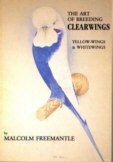 Click on the book to order.
Click on the book to order.Although the Budgerigar has existed in Britain since 1840, having been introduced to this country by the naturalist John Gould on his return from Australia, it was not until 1934 that the first Clearwing appeared. This bird arrived as a present for King George V, who at that time was Patron of the Budgerigar Society. Three years later, the Clearwing was first seen on the show bench and several well known fanciers of the day were then breeding and improving from the original arrival and its offspring. The well known geneticist and author, Cyril Rogers was, one of those dedicated breeders. Once the 1939 war commenced, regrettably their progress was halted and it was not until the 1950's that the fancy saw any significant improvement in this variety.
It was in 1958 that Mrs. K.B.N. Malcolmson set the exhibition world alight in both of the Clearwing series. Her stud during the period 1958-68 excelled above everyone in both wing clarity and depth of body colour. Furthermore their size was bigger than anything else on the showbench.
The National Exhibition of Cage Birds was, in those days, held at Olympia in London and at that time was regarded as a major budgerigar show. It was not unusual for Mrs. Malcolmson to field a large team of Clearwings in Adult and Breeder classes and take all seven places in each section in both varieties.
Very regrettably, this marvellous era came to an abrupt end. A judge, who had hitherto never seen birds of this size and quality, decided at the Budgerigar Society World Championship, to disqualify her entries on the grounds that all were long flighted. A few weeks later the same birds appeared at National and won yet again. Unfortunately all this unsettling publicity was too much for Mrs. Malcolmson; a burglary followed in which some of her best exhibits were stolen, and the end result was that she sold out completely and vanished from the hobby.
In 1963, S.D. Parsons circulated all the Clearwing breeders in the United Kingdom with the idea of forming a specialist society. The inaugural meeting was held in London in December of that year and the Clearwing Budgerigar Breeders Association was born. Since then the Society has forged ahead and in 1970 had the distinction of becoming the first Specialist Society to be accepted for Associate Membership of the Budgerigar Society. Membership now boasts fanciers from all over the World, with members from USA, Australia, New Zealand, Japan, South Africa, Italy and many other European countries.
The C.B.B.A., as it is known, was formed to promote the advancement of the Clearwing and this does not include the Opaline or Cinnamon forms which are 'imperfect'.
The Yellow-wing Green and Whitewing Blue series are bred in all the known body shades i.e. Yellow-wing Light Green, Dark, Olive and Greygreen and Whitewing Skyblue, Cobalt, Violet, Mauve and Grey. The Budgerigar Society have laid down the standard for Exhibition Clearwings as follows:
Mask: Buttercup Yellow
Cheek Patches: Violet
General Body Colour: Back, rump, breast, flanks and underparts, Bright Grass Green.
Wings: Yellow, as free from markings as possible.
Tail: Long feathers, bluish
Other green shades will be darker in proportion except the Greygreen which will have a dull Mustard Green body colour and Grey to Slate cheek patches.
Mask: White
Cheek Patches: Violet
General Body Colour: Back, rump, breast, flanks and underparts, pure Skyblue
Wings: White, as free from markings as possible
Tail: Long feathers, bluish.
Other blue shades will be darker in proportion except the Grey which will have a Grey body colour and cheek patches, grey-blue. It should be noted that the Greygreen and grey come in light, medium and dark shades.
Size, Shape, Balance and Deportment 35
Size and shape of head 25
Colour 15
Variety Markings 25
(Points are not allocated for Mask and Spots).
There is no standard or scale of points for the other forms of Clearwing, although this must come in the full course of time, much discussion will need to take place to get a uniform standard, which will accommodate all breeders views. The Cinnamon Clearwing for example crops up in many Fanciers breeding rooms, without them identifying the bird as being different from the Normal Clearwing and until we can get the breeder to understand and take time to recognise the Cinnamon form, we are a long way from setting a standard.
One of the most difficult aspects is to maintain clarity of yellow (clear buttercup) or white, in the wings. Very often they are dark, this fault being very difficult to eradicate. Years ago light yellows were available which were ideal for improving the Clearwing colouration. Unfortunately, this source of outcross is a rarity and even if they were available, it is doubtful if their small size would benefit the Clearwings of today. It is easier these days to seek out a large white to help with the Whitewings.
Many Champion Breeders have decided, to try their hand at this variety and almost as many have dropped by the wayside by attempting to pair their large Normals or Grey Yellows to one of the smaller Clearwings. Unfortunately they achieve very few Clearwings from these pairings and find the following year they have no birds to pair up to produce Exhibition Clearwings.
Today the Clearwing is an accepted contender at nearly every show where budgerigars are exhibited. Those who seek a challenge and love budgerigars for their beauty, would do well to consider breeding these birds.
Malcolm Freemantle is Author of the book The Art of Breeding Clearwings  Click on the book to order.
Click on the book to order.